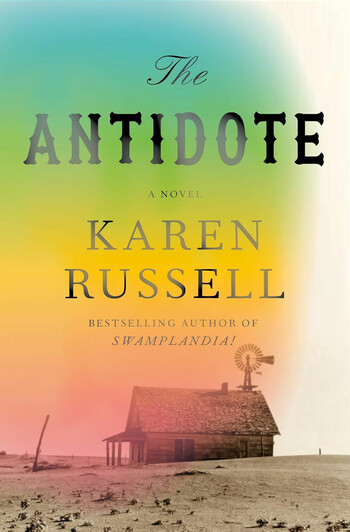A “prairie witch” uses an emerald-colored ear trumpet to collect deposits of memories from settlers on the Great Plains, promising relief from guilt and shame. A sentient scarecrow inexplicably survives a severe dust storm and seems to be filled with more than straw. A New Deal photographer’s magical camera offers startling visions of a Nebraska town’s inescapable past and its potential futures.
These strange occurrences feel right at home in the alternative dust-bowl-era Nebraska dreamed up by Karen Russell ’06SOA for The Antidote, her first novel since the 2012 Pulitzer Prize finalist Swamplandia! Since the release of her debut 2006 story collection St. Lucy’s Home for Girls Raised by Wolves, Russell has garnered accolades for her spellbinding fiction that injects fantastical elements into life as we know it, illuminating profound human truths. With The Antidote, an ambitious, deeply researched epic, Russell builds on this foundation, refracting American history through the lens of the surreal — to eye-opening effect.
Set in the fictional town of Uz — a name borrowed from the book of Job by devout Polish farmers who founded the settlement — the novel opens with a true historical catastrophe. On Black Sunday, April 14, 1935, a dust storm pummels the Great Plains as “the soil rose in mutiny against the farmer,” as Russell puts it.
In Russell’s invention, the storm also bankrupts Uz’s prairie witch, one of the novel’s four narrators. The witch, known as the Antidote, gained the power to enter a trance and absorb others’ memories when her baby was stolen from her at a state-run maternity home — the real Milford Industrial Home — when she was fifteen. The shock left her with an open wound that could be filled with customers’ secrets in a “painless exchange,” leaving her with no conscious understanding of what they whispered into her ear horn. But the Antidote wakes amid the storm to find that the whirling dust cloud has siphoned fifteen years of memory deposits.
While the Antidote grapples with her sudden loss, wheat farmer Harp Oletsky finds his land curiously untouched. The sole survivor of one of Uz’s founding families, the forty-five-year-old bachelor has held on through four years of drought and crop failure that have left him deeply in debt. But after the storm, the air above his farm is fresh, his scarecrow stands tall, and stalks of green wheat stud his fields. To Harp, an earnest man who has “witnessed the extraordinary sorrows that ordinary people must bear,” from the suicide of his shell-shocked veteran brother to the recent murder of his estranged sister, this miracle is not solely joyous. He is terrified about what it portends — especially since he’s the only farmer whose land was spared.
Russell interweaves the alternating stories of the Antidote’s loss and Harp’s luck with those of two other narrators — Harp’s orphaned teenage niece Asphodel, who sublimates her grief for her mother by dedicating herself wholly to basketball, and Cleo Allfrey, a Black photographer who has been hired by the Resettlement Administration to document rural poverty à la Dorothea Lange.
While Russell takes her time connecting the dots between these characters, what unites their perspectives is a preoccupation with the slippery nature of memory. Allfrey is conscious that her photographs “substitute for memories” but also that “a memory is never the fullness of what happened.” Asphodel feels her murdered mother is “dying a second time” as memories are “fraying and fading” inside her, and Harp refuses to visit a prairie witch to unburden himself of painful memories of his siblings. The Antidote holds tight to her weakening memory of her stolen son and gradually comes to terms with her complicity in excising Uzians’ secrets. “There is no safe way to remove chapters from the book of one’s life,” she explains.
When Russell finally brings all four narrators together, they reassemble a collectively suppressed memory about the greatest betrayal of their country. What the Antidote and other prairie witches have helped willfully conceal from settlers like the Oletskys — and what Allfrey’s magical camera reveals — is the complicity of their ancestors in stealing Native territory. The land in Nebraska and other Great Plains states that the government advertised as free to homesteaders was the homeland of Indian tribes. In uprooting centuries of Indigenous wisdom about tending the prairies, the government and settlers laid the groundwork for the soil erosion that would lead to the dust bowl.
The myths of terra nullius and manifest destiny depend on collusion and collective amnesia. In The Antidote, Russell reveals the great cost of buying into those myths by spinning an enchanted story of her own. It is a rare work of fantastical historical fiction that demystifies rather than repeats the distortions of the past. “Shame is a guide, if you can direct its burning light to the next right action,” Russell writes. The Antidote illuminates paths toward possible restoration.



